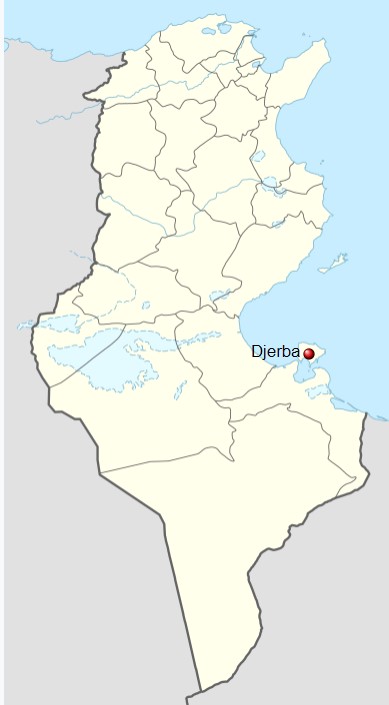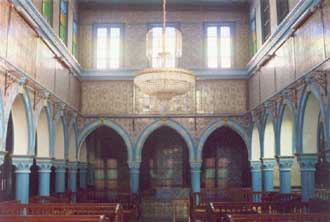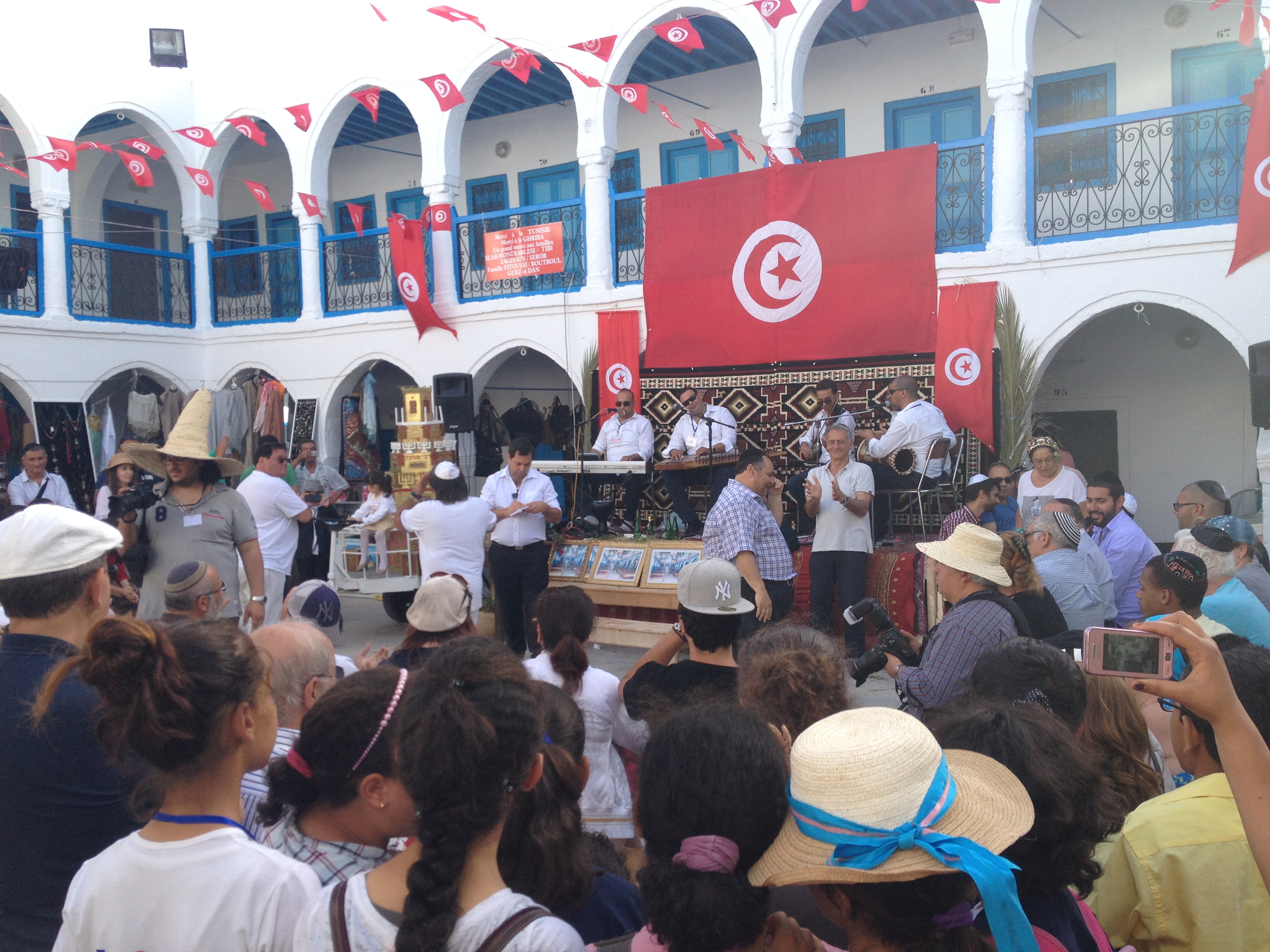Virtual Jewish World: Djerba, Tunisia

Djerba is an island off the coast of southern Tunisia, 500 km (300 miles) from the capital Tunis.
 |
|---|
In ancient times Djerba was an important Phoenician trading center. According to the local tradition, the first Jews may have come from Judea about 3,000 years ago, at the time of King David and King Solomon, or at the time of the destruction of the First Temple and the forced Babylonian exile in 586 BCE. They were probably joined by the Jews who fled Jerusalem after the destruction of the Second Temple in 70 C.E. and others who ran from the Spanish Inquisition. They settled in two separate communities: Hara Kabira (the large Jewish quarter) and Hara Saghira (the small Jewish quarter).
The priestly Kohanim who escaped from Jerusalem in 70 CE settled in Hara Saghira, and their descendants still live there today. According to tradition, the absence of Levites on the island is the result of a curse against them by Ezra because they refused to answer his request to send Levites to Eretz Israel (cf. Ezra 8:15), and they all died.
The history of the Jews of Djerba includes three serious persecutions: in the 12th century under the Almohads; in 1519 under the Spanish; and in 1943 under the Nazis. In 1239, a colony of Jews from Djerba settled in Sicily, where they obtained concessions to cultivate henna, indigo, and the royal palm groves. It was common for the male Jewish population of Djerba to look for livelihood abroad, but they kept returning to the island, where their families had remained. The exchange of goods with Malta and Italy was in the hands of the Jews, who grew the products and processed the commodities for export themselves. Maimonides, in a letter to his son, expressed a low opinion of their superstitions and spiritual capacity but praised them for their faith.
In the 19th and 20th centuries, the yeshivot of Djerba produced many rabbis and writers, and they provided rabbis for the communities of North Africa. In 1976, some 300 youngsters received a Jewish education. In the early 1990s, the American Jewish Joint Distribution Committee provided funding for Jewish education (including a girls’ school) with a combined enrollment of 245. David Idan established a Hebrew printing press in Djerba in 1903, and many books, mainly Passover Hagaddot and liturgical items, were printed there. The Djerban Jews are famed for their filigree jewelry, and many today still work as gold and silversmiths.
In 1946, about 5,000 of Tunisia’s 105,000 Jews lived in al-Ḥara al-Ṣaghīra, al-Ḥāra al-Kabīra, and Houmt-Souk, the principal town of the island. Their number dwindled with most immigrating to Israel and settling in moshavim (many of them on moshav Eitan) when the state was founded, and others leaving during periods of fear and insecurity, such as the 1956 Sinai Campaign, the 1967 Six Day War, and the government’s brief stint with nationalism in 1969-70. Many French-speaking Jews also moved to France, and by 1993, only 670 Jews lived on the island, and the Jewish neighborhoods lost their purely Jewish character as Muslims moved in.
The community rebounded, and today, 1,100, 75% of Tunisia’s 1,500 remaining Jews, live on the island with 175,000 Muslims. The Jews dress exactly like their Muslim neighbors – the men in red felt hats, tunics, and pantaloons and the women in long dresses and head-coverings, while the younger generation dresses in Western-style garb. The only distinguishing feature is a narrow black band at the bottom of the men’s pantaloons, a sign of mourning for the destruction of the Temple.
Tunisian Jews typically speak French; however, those in Djerba speak a local Judeo-Arabic dialect, which is written in Hebrew characters. They proudly identify as Zionists. There are several kosher restaurants with signs in Hebrew, Arabic, and French.
The children’s first language is Arabic, but they learn the aleph-bet and basic Hebrew prayers at a day school. By eight or nine years old, Djerba boys are undertaking serious Gemara studies at a yeshiva.
Because they lived in virtual isolation from the rest of the world until the advent of 20th-century mass tourism, the Jews of Djerba have been able to preserve a very undiluted form of Judaism. The whole community is religiously observant and maintains 12 different synagogues (some are only open on holidays). Once a month, a minyan stays up all night studying and praying. Boys and girls do not meet alone before they are married, and even older men and women are rarely seen in public together. The conservative, traditional Jews of Djerba are fairly insular, keeping themselves apart from other Jews in Tunisia and abroad. Their spiritual leader is Chief Rabbi Haim Bitan.
The most famous synagogue in Tunisia, and the oldest in Africa, is the El Ghriba synagogue in the village of Hara Sghira on Djerba. The current building was constructed in the late 19th or early 20th century, but the site is believed to have had a synagogue on it for the past 1,900 years. The restored white building with its ornate interior is only about a century old, but it is built on the foundations of all the Ghribas that preceded it. The many legends that circulate about El Ghriba say that its foundation stone, or perhaps a gate, came from Solomon’s temple.
The Guellela Museum has displays on the island’s culture, including exhibits on Jewish religious practices and customs. The Museum, Ivri said, “conveys an overlying message that is promoted by the government and many of the Muslims I would encounter…the Jews among us are part of the Tunisian nation, only different by their religion.
 |
|---|
In 2018, Noam Ivri reported that Rabbi Bitan allowed boys to go on a special Birthright Israel trip but prohibited any girls from participating over concern for potential immodesty and secular influence.
The Muslims and the Jews, and Djerba live side by side in relative peace. Indeed, there is a lot of crossover between the two groups. The kosher restaurant, L’Oscar, serves staples that are typical local dishes eaten by the local Muslims, such as couscous and spicy red harissa sauce. Muslim farmers deliver chickens to a Jewish stall to be inspected for the kosher ritual slaughter, and a Muslim man bakes bread for the Jews on Shabbat.
Nevertheless, the community was the victim of several anti-Jewish incidents. In October 1980, a Jewish boy was sentenced to five years in prison (but released two months later) for destroying an Islamic religious manual during a 1978 schoolyard scuffle. Following the Israeli invasion of Lebanon in 1982, Jewish homes and shops in Djerba were ransacked and set on fire on Yom Kippur, and several Jews were injured.
Tunisian Jews have for centuries made an annual pilgrimage to the synagogue on Lag b’Omer, and the Tunisian government encourages visitors, even inviting Tunisian Jews from Israel, with which it has no diplomatic relations, to participate. The Lag b’Omer festival subsequently became one of the largest modern Jewish gatherings in the Arab world, attracting more than 6,000 pilgrims.
“People come from everywhere to attend the pilgrimage,” Moszché Uzan, the assistant to Tunisia’s chief rabbi, told Jewish Insider. “It’s a religious pilgrimage, but it’s also — people come here to be happy, to hear songs, to dance, to eat. Everyone finds every kind of thing here.”
The celebration centers on a legendary woman named La Ghriba (Arabic for “the foreigner” or the “extraordinary one”), who lived on the island at some unspecified time in the distant past. There are multiple versions of the story, but the one most often heard speaks of a beautiful, pious woman who lived alone and had no family or intimate connections. One night, her house caught on fire. She was found dead but miraculously unblemished by the blaze. The local inhabitants hailed her as a kind of saint and decided to bury her at the site of the catastrophe. To honor her, they built a sanctuary, which was subsequently named El Ghriba.
Today, pilgrims come on Lag B’Omer to ask her for help. Barren women claim they became pregnant after asking La Ghriba to intercede, and others who were single got married. Many miraculous healings are also attributed to her intervention.
The centerpiece of the Lag b’Omer celebration is a huge, wooden candelabrum shaped like a wedding cake called the Grande Menara. It is adorned with multi-colored scarves, set on a rolling cart, and wheeled through the streets of Hara Saghira. Women rush up to spray the Grande Menara with perfume and embrace her. There’s an auction where spectators bid hundreds of Tunisian dinars for the right to ride a few yards atop the cart (the money goes to support the synagogue for the coming year). The procession is accompanied by musicians, and there is much joyous dancing and singing.
Several incidents over the years discouraged pilgrims. On May 9, 1979, a fire (labeled by the government an “accident”) broke out, destroying seven Torah scrolls, the ark, and prayer books. During the Simchat Torah prayers in October 1985, a Tunisian guard posted by the government for protection shot at the congregation, killing five (including a policeman) and wounding eleven. He was convicted and sentenced to a mental institution. On April 11, 2002, a few weeks before Lag b’Omer, an al-Qaeda suicide bomber drove a truck full of explosives that exploded outside the El Ghriba Synagogue, killing 21 people and prompting the government to provide round-the-clock security and erect a blast-proof wall.
Following the Arab Spring upheaval in 2011, the celebration in Djerba was severely cut back, and in 2012 only a few dozen participants showed up amid fear of possible attacks by hardline Islamists. However, in 2013, hundreds of Jews came for the three-day celebration as Tunisian police promised the secure the event and ensure the protection of the Jewish revelers.
“The strong presence of security is a positive step and sends a message to the Jews in the world that Tunisia protects us even if its leaders are Islamists”, said Perez Trabelsi, the head of the Jewish community in Djerba. “Jews in the world will see the government's efforts to make the celebration safe and will return in their thousands over the next few years and will not pay attention to any threat,” he added.
Despite heavy security, a Tunisian naval guard opened fire during the holiday celebration at the El Ghriba Synagogue on May 9, 2023. Aviel Haddad, a 30-year-old dual citizen of Tunisia and Israel, and his 42-year-old cousin, Benjamin Haddad, a French-Jewish businessman living in France, were killed, along with three guards. Nine others, including four civilians, were injured before the gunman was killed by security guards.
Ambassador Deborah Lipstadt, the U.S. special envoy to monitor and combat antisemitism, and U.S. Ambassador to Tunisia Joey Hood attended the festival hours before the attack.
Tunisian President Kais Saied claimed the attack in Djerba wasn’t anti-Semitic and attacked Israel, saying that Palestinians “are killed every day” and “no one talks about it.”
A coalition of over 20 non-Jewish Tunisian rights organizations condemned the statement for confusing the Palestinian cause and anti-Semitism.” The coalition denounced “the poor management of the crisis, which has been characterized by censorship and misinformation, the minimization of the seriousness of the operation and the primacy given to its economic impact.”
The Conference of European Rabbis (CER) called on European governments “to condemn the inflammatory statements of President Kaies Saied of Tunisia implying that the Jews of Tunisia are responsible for the bombing of Gaza.” CER President Pinchas Goldschmidt said, “Through such wanton remarks, the president continues to incite further hatred and even attacks against the country’s Jewish community, heaven forbid. … The Tunisian President together with the relevant authorities should instead be offering support to the Jewish community and working to ensure its safety.”
Saied subsequently met with the chief rabbi, chief Christian archbishop, and Muslim mufti and told them, “We will provide you security in your temples. Live in peace and security, and we will provide you with all security conditions.”
BIBLIOGRAPHY
N. Slouschz, Travels in North Africa (1927), 251–68; R. Lachmann, Jewish Cantillation and Song in the Isle of Djerba (1940); R. Brunschwig, La Berbérie orientale sous les Hafṣides, 1 (1940), 399; Pinkerfeld, in: Cahiers de Byrsa, 7 (1957), 127–88; A.N. Chouraqui, Between East and West (1968), index S.V. Djerba. ADD. Bibliography: American Jewish Year Book, 1972, 1978, 1985, 1994; H.Z. Hirschberg, A History of the Jews in North Africa, 2 vols. (1974–81), index; A.L. Udovitch and L. Valensi, The Last Arab Jews: The Communities of Jerba, Tunisia (1983); B. Haddad, Sefer Jerbah Yehudit (1978); Y. Mazouz, Yahadut Jerbah (1979); R. Attal, "Djerba, centre de diffusion du livre hébraïque," in: M. Abitbol (ed.), Communautés juives des marges sahariennes du Maghreb (1982), 469–78; G. Memmi, Une île en Méditerranée (1992); Les Juifs de Jerba: 25 siècles d'histoire (1990).
[David Corcos / Rachel Simon (2nd ed.)]
Sources: Encyclopaedia Judaica. © 2007 The Gale Group. All Rights Reserved.
Noam Ivri, “The Jews of Djerba,” Jerusalem Report, (November 26, 2018).
Gabby Deutch, “Hours before deadly attack, coexistence on display at Tunisian Jewish festival,” Jewish Insider, (May 10, 2023).
Canaan Lidor, “Two worshipers killed in attack at Tunisia synagogue during pilgrimage,” Times of Israel, (May 10, 2023).
Gabe Friedman, “Days after synagogue attack, Tunisian president criticizes Israel and says his country saved Jews in WWII,” JTA, (May 16, 2023).
Zvika Klein, “Tunisian president claims Djerba synagogue shooting wasn't antisemitic,” Jerusalem Post, (May 15, 2023).
Gabe Friedman, “Tunisian president pledges security for Jews after synagogue shooting and controversial comments,” JTA, (May 18, 2023).
Photos: Map = Karte: NordNordWest, Lizenz: Creative Commons by-sa-3.0 de, CC BY-SA 3.0 DE via Wikimedia Commons.
Celebration - Quatchenerlo, CC BY-SA 4.0 via Wikimedia Commons.
El Ghriba synagogue - Chapultepec licensed under the Creative Commons Attribution-Share Alike 3.0 Unported license via Wikimedia Commons.


